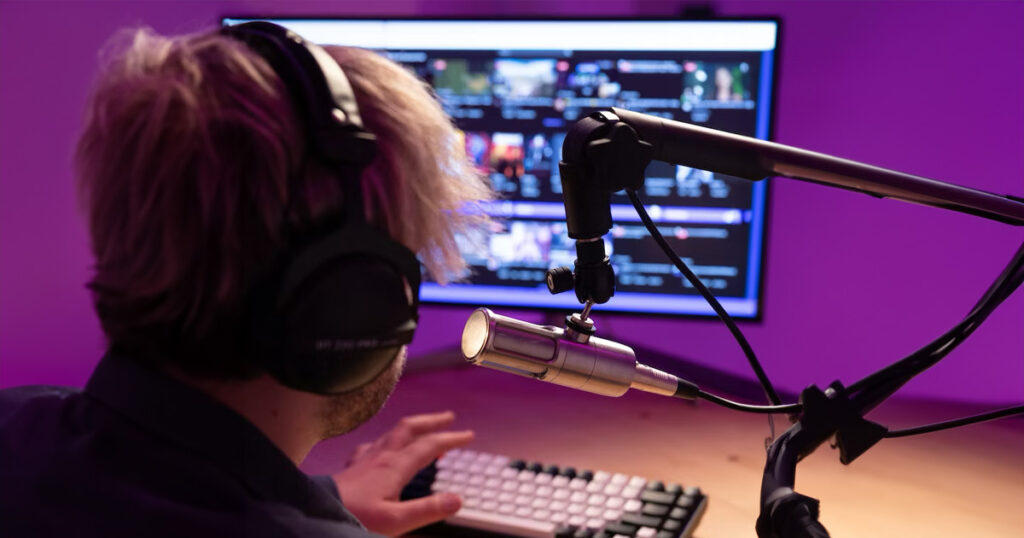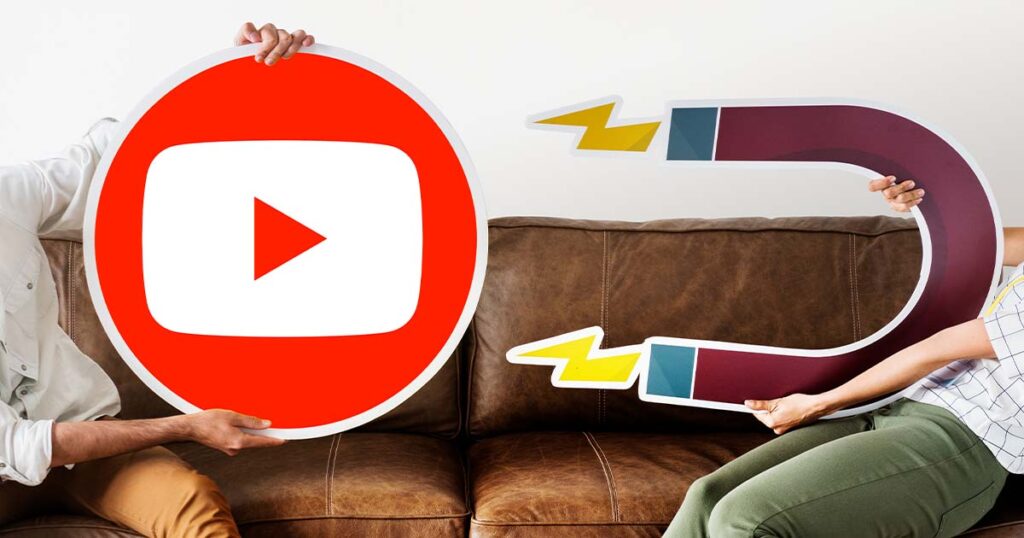Technically, all it takes to become a YouTuber is to set up a YouTube channel and start posting videos. But if you want to be a successful YouTuber you need to be strategic about how you build your channel.
The key is consistency. Most professional YouTubers regularly post videos around a similar theme, engage with their audience and aren’t afraid to cross-promote their content on other social media platforms. Following these steps can help you reach views and subscribers you need to start making money and — who knows — maybe even quit your day job.
How to become a YouTuber in 12 steps
- Find your niche
- Set goals for your channel
- Research the competition
- Get to know your future audience
- Create a content schedule
- Assess your equipment
- Start making videos
- Launch your YouTube channel
- Post videos regularly
- Learn from YouTube analytics
- Engage with viewers and promote your channel
- Monetize your channel
Step 1: Find your niche
The most successful YouTubers post videos around a specific theme — or niche. Even if you have an idea of what you want to do, sit down and ask these questions to nail down your niche:
Who are you?
Try this exercise: Complete the sentence “I am a…” ten times and see what you come up with. For example: I am a writer, a runner, and a home cook. This list should reflect topics that you’re comfortable calling yourself an expert in.
What’s your unique take?
Take your answers to the “I am a…” exercise and ask yourself what gives you a unique perspective on each topic. This will help you find your sub-niche. For example, if you wrote I am a woodworker but your real passion is carving small objects out of wood, this is where you would narrow down your niche from “woodworking” to “whittling”. Zooming in on one topic helps you reach an audience that’s actually invested in your experience or expertise — and also narrows down the competition.
What do you know that other people don’t?
Think about those moments that frustrate you when you’re watching a movie or TV show when you know that’s just not how it’s done. That’s what inspired Devin Stone, the lawyer and law professor behind the LegalEagle channel. He uses the platform to make tongue-in-cheek reviews of pop culture depictions of the law shows like Better Call Saul and Legally Blonde. This approach offers a great way to both entertain and educate the general public, while also fighting misinformation.
What are you already doing that you could share with the world?
There’s a chance you’re doing something that would make a great YouTube channel if you just recorded it. For example, industrial designer Rob Jensen was already teaching his children how to draw when he created the channel Art for Kids Hub. His kid’s school had discontinued its art program and he wanted to make sure they still had a creative outlet in their lives. Art For Kids Hub was eventually so successful that he quit his job as an industrial designer at Ford.
Do you have any personal goals?
Documenting a journey can be a great way to build up a subscriber base and hold yourself accountable to your personal goals.These often fall into the self-improvement niche, including YouTubers like Beatrice Caruso — who created her channel when she decided to lose weight — and Elizabeth Chu — who uses her channel to document her attempt to build a meaningful life for herself during her early twenties. Building a channel around a goal can be a great starting point since there’s a built-in narrative that’s exciting enough to keep viewers coming back for more. Once you’ve established yourself in that niche — or met your goal — you can expand the types of videos you create.
Step 2: Set goals for your channel
Creating measurable goals for your channel is a great way to make sure you stay on track and don’t lose steam.
First, base your goal around the number of videos you create. For example, you might set a goal of making 10 videos over two months before you get your channel started.
After your first few video goals, consider focusing your goals on views and subscribers. You generally can’t start to make money off your channel until you hit about 4,000 views over a 12 month period and 1,000 subscribers. So if making money is important to you, consider setting that as a goal.
Only after you’re eligible for monetization should you consider switching to financial goals. Racing a financial goal involves hitting those view and subscriber targets but also putting yourself in the position to work with sponsors and even selling merch.
Step 3: Research the competition
Now you finally have an excuse to spend all day watching YouTube videos. Get familiar with the YouTubers who are popular in your niche. You may want to take note on the following:
- What topics are they covering? Make a list of titles to get an idea of common terms that come up with your competitors.
- Do they have a popular or top videos playlist? What videos are included there? Are there any themes across different channels?
- What kind of content are they making? Some YouTubers rely on listicles, others specialize in reviews while others like to tell a story or make an argument. Take note of the narrative structure they’re using and see if any feels natural to you.
- What kind of footage are they using? Some YouTubers rely on a lot of b-roll as the backdrop to a voiceover. Others might rely on a talking head format — or film themselves doing something. Many use a combination.
- What equipment do they use? Some YouTubers list the equipment they use in the descriptions on their video (often as part of a sponsorship deal). While you might not need to invest in that equipment now, take note of what you might need down the line.
- What do you like? Write down anything and everything that you like about your competitors — from the background music they use to the way they use lighting.
- What’s missing? Is there anything your competitors aren’t covering that you think would be interesting? It’s up to you to fill those gaps.
Step 4: Get to know your future audience
Look at who’s watching your competitors’ videos for a heads up on who might be clicking on your thumbnails. Go to the comments sections and jot down answers following questions:
- What do they like and dislike about your competitors?
- Why are they watching your competitor’s videos?
- What do they gain — or want to gain — from watching these videos.
You may be able to get a general sense of your niche’s demographics by looking at commenter profiles. But remember, most viewers don’t comment on videos so this won’t give you a full picture of your audience.
As you start getting views, you’ll be able to get to know your own audience better by using YouTube analytics.
Step 5: Create a content schedule
A content schedule, or content calendar, is a plan for when you post videos onto your channel. It’s key to staying consistent.
Start by brainstorming ideas for content
You are absolutely allowed to make videos on topics that are near and dear to your heart. But if you want to be successful on Youtube, you also need to research what topics and questions people are asking about your niche. Focusing your content around popular topics is key to search engine optimization, or SEO, which can help make sure you show up in YouTube and Google search results.
The simplest way to create an SEO-based content plan is to enter common words you’ve noticed your competitors using into the YouTube search bar. Take note of the autocomplete suggestions and use these as ideas for video topics or subtopics.
If you want to get a little more advanced, you can also use free search engine optimization tools like Moz to find the keywords viewers are using the most around your topic on Google. This won’t be exactly the same as YouTube, but can give you an idea of what topics might give you the most views. You can also use a free tool like Answer the Public to get a list of common questions people ask about different topics.
These free strategies and tools are a great place to start. But as you develop your channel, you may want to subscribe to a paid SEO service such as Ahrefs, SEMrush, TubeBuddy or vidIQ.
Learn more: Our Complete Guide to YouTube SEO
Make a schedule
All you really need to make a content schedule is a spreadsheet and some keyword ideas. As you move along, you might want to consider using a tool like Trello or Jira to keep track of your workflow — especially if you have a production team. But it’s not necessary when you’re starting out.
You may want to include the following columns on your content plan spreadsheet:
- Video title or topic
- Target keyword or keywords
- Search volume — if you know how many people are searching for that keyword
- Film date
- Edit date
- Upload date
- Footage link
- Video link
Add other columns as you see necessary. For example, you may want to include a column for thumbnail images or any graphics if you find yourself scrambling for those links come upload time.
Once you’ve set up your content schedule, set aside a time to check on the spreadsheet each week to make sure you’re on track.
Step 6: Assess your equipment
You probably already have what you need to make a YouTube video but it helps to make sure you have the following before you start filming:
- Camera — this can be your phone
- Editing software
- Internet connection
You can still be a successful YouTuber if you only use your phone to shoot and edit equipment, especially when you’re just starting out. Save those big equipment purchases for after you’ve shot several videos and have a better sense of where you need to invest.
Step 7: Start making videos
Now that you know your content schedule, you’re ready to start shooting. Don’t worry about the quality of your first few videos. The main purpose of getting started is to help you find your aesthetic and find a process that works for you.
Nail down the structure
Most successful videos have a beginning, middle and end.
The beginning is where you introduce yourself, your brand and the topic of the video. Many YouTubers use the same style of intro for most videos, to create a sense of continuity across their channel. This is also where some YouTubers like to include calls to actions, or CTAs, where they ask viewers to like, subscribe and turn on notifications for your channel.
The middle should be the majority of the video. If you find yourself prone to tangents, try writing out a script or notes to help you stay on topic.
Use the end to summarize the middle of the video and include a CTA inviting viewers to watch more videos on your channel. This is another popular place to ask viewers to like, subscribe and turn on notifications.
Experiment with lighting
While you’re shooting your first videos, try out different types of lighting to help you decide where to shoot. If you want to rely on natural light, experiment with the time of day that you want to shoot — and remember, this will change from season to season. If you want to shoot indoors, experiment with the lights you already have before investing in a ring light or other indoor lighting equipment.
Find your vibe
Even though you might have had an aesthetic in mind when you were planning out your videos, the filming and editing process will help you nail down the way you want to present your channel. Having an authentic, consistent aesthetic will help you become more recognizable to your viewers than if your videos and graphics were all over the place.
Spend time on titles and thumbnails
Viewers will be going entirely off the thumbnail and title when they first come across your content, so spend some time figuring out what works. Here are a few tips to draw viewers in:
- Include your face. Adding an image of your face can help viewers feel a sense of connection. It gives potential viewers the sense that there’s a real person behind the channel. Plus it’s an easy way to communicate emotion.
- Balance your image. Most successful YouTubers balance their thumbnails with text on the left and an image on the right.
- Keep it consistent. Your thumbnails should use the same typeface, size, color scheme and layout.
Revise, revise, revise
Watch your edited videos all the way through before you upload them and ask yourself the following questions:
- Does the content reflect the title of the video? You’ll leave viewers frustrated if your video goes off topic. If your video is “How to make a pecan pie,” don’t give them a cherry pie recipe instead.
- Does it get to the point as quickly as possible? While intros are necessary, getting to the point can reassure viewers that they clicked on the right link.
- Does it entertain or educate? These are the two most popular reasons people go to YouTube. Have a friend or relative watch your first videos and ask if they learned anything or enjoyed watching it.
If it doesn’t meet all of these criteria, take note of what needs to change. In some cases, you may need to make some simple editing tweaks. In others, you might have to reshoot the whole thing.
Step 8: Launch your YouTube channel and start uploading
Creating a highly-optimized YouTube channel can be a complicated process. But here are the basic steps you need to follow to get started:
- Create a Google account for your channel. Google owns YouTube so you need a Google account to use the video platform. You can connect YouTube with your personal Google account, if you already have one, but some people prefer to keep those separate.
- Create a YouTube channel. Once you’re logged into Google, click the icon in the top right corner and select Create a channel. Follow the instructions to set a channel name, YouTube handle and upload a picture.
- Customize your channel page. Go to your channel page and click Customize channel. You don’t need to do everything right away, but make sure you complete the branding and basic info tabs with your photo, banner image, bio and links to any other content you’d like your viewers to visit.
- Start uploading. Go to your channel dashboard and follow the instructions to upload the videos you’re ready to publish.
- Set a publishing schedule. You can publish your first video right away. For the rest of the videos, go to the visibility tab and follow the instructions to schedule the date, time and time zone that you’d like each video to go live.
Step 9: Learn from YouTube analytics
After you’ve racked up a few views (or even just one view), this is your chance to really get to know your audience. Set aside time at least once a week to review which videos are doing well, which aren’t and where your views are coming from.
Step 10: Engage with viewers and promote your channel
Respond to comments, post links to your videos on social media and other websites to create a sense of community with your channel. If you don’t have comments yet, you can still engage with viewers by responding to comments on your competitor’s channels — or post comments yourself.
Engaging with your audience can help people be seen and ensure people come back for more of your content. Engaging with creators can help create a sense of community and can open doors for collaboration down the road.
Step 11: Monetize your channel
In most cases, you need to meet the following criteria before you can start making money from your YouTube channel:
- 1,000 subscribers
- 4,000 views over a 12-month period OR 10 million shorts views over the last 90 days
Those are the requirements to sign up for the YouTube Partner Program. When you join the YouTube Partner program, you can earn money from ads people watch on your page, create subscription-based fan club, set up a merch store and more.
5 more ways to make money on YouTube
Signing up for the YouTube Partner Program is only one of several ways to monetize your videos.
- Google AdSense is another way to make money from ads on your YouTube video. The main difference between AdSense and the partner program is that you have less control over which ads appear on your videos.
- Affiliate partnerships involve making a deal with a company to include links to its products in your description. YouTubers sometimes affiliate deals for the equipment, clothes and makeup they use to make their videos.
- Sponsored content involves doing a bespoke ad for a particular product in your video. Unlike written sponsored content, the topic of your video doesn’t have to directly relate to the product but it should fit in with your channel’s aesthetic.
- Patreon and other paid subscription platforms allow you to create more exclusive content for your viewers, as an alternative to what’s allowed in the YouTube partner program.
- Merchandise sold through the YouTube Partner Program or on a separate website offers a way to monetize your account without having to add to your filming schedule.
Final thoughts
If there’s one thing you take away from this article is that consistency and planning are essential to becoming a successful YouTuber. Starting a YouTube is exciting in the beginning. But having a content schedule and routine for regularly creating content is key to pushing through when motivation starts to lag.
Listening to your audience, whether it’s through YouTube analytics or reading and responding to comments is also a huge part of building the subscriber base you need to make YouTube your career.
Visit our guide to content creation for more ideas on how you can build your personal brand across other platforms — not just YouTube.




